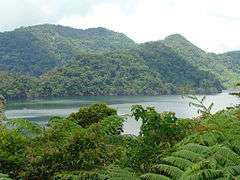Lake Balinsasayao
| Lake Balinsasayao | |
|---|---|
|
| |
.svg.png) Lake Balinsasayao Location within the Philippines | |
| Location | Negros Oriental |
| Coordinates | 9°21′11″N 123°10′45″E / 9.35306°N 123.17917°ECoordinates: 9°21′11″N 123°10′45″E / 9.35306°N 123.17917°E |
| Type | Crater lake |
| Basin countries | Philippines |
| Max. length | 1.5 kilometres (0.93 mi)[1] |
| Max. width | 1 kilometre (0.62 mi)[1] |
| Surface area | 76 hectares (190 acres)[1] |
| Max. depth | 90 feet (27 m)[1] |
| Surface elevation | 1,000 feet (300 m) |
| Settlements | |
Lake Balinsasayao is one of three crater lakes rising 1,000 feet (300 m) above sea level located within the Balinsasayao Twin Lakes Natural Park, an 8,016.05-hectare (19,808.1-acre) protected area covering the municipalities of Valencia, Sibulan, and San Jose in the province of Negros Oriental, Philippines.[2]
History
Lake Balinsasayao, Lake Danao, and Lake Kabalin-an are part of Balinsasayao Twin Lakes Natural Park, a protected area totaling 8,016 hectares (19,810 acres) created on 21 November 2000 by virtue of Proclamation No. 414 signed by former President Joseph Estrada. It lies within the municipalities of Valencia, Sibulan, and San Jose in the province of Negros Oriental.[2][3]
Geography

The lakes are situated northwest of a narrow mountain ridge, in a caldera formed by four mountains: Mount Mahungot to the south, Mount Kalbasan to the north, Mount Balinsasayao to the east and Guintabon Dome to the west.[4] A normal fault separates Lakes Balinsasayao and Danao while and another fault, the Amlan, is about 1,400 metres (4,600 ft) west of Danao. Four geologic faults also intersect the southern edge of Lake Danao, whose water level is lower than that of Balinsasayao.[5]
Flora and fauna
As a protected natural park home to an expansive ecosystem and biodiversity, Balinsasayao Twin Lakes National Park is one of the major tourist attractions in Negros Oriental.[4] The lake has a rich fish fauna and the surrounding dipterocarp forests are rich in bird life. However, invasive fish species such as tilapia, common carp, mudfish, shrimp, mosquito fish and milkfish have been introduced in the lake.[6][7]
Tourism
The Department of Environment and Natural Resources (DENR) through the Biodiversity Management Bureau (BMB) manages tourist activities in the natural park. The bureau allows swimming, sightseeing, mountain trekking, camping, birdwatching, paddle boating in Lake Balinsasayao. The natural park has a concrete view deck, umbrella cottages, a restaurant, a souvenir shop, restrooms, and a visitor center.[8]
Conservation
Conserving the natural park's flora and fauna is a continuing struggle as surrounding forests are exploited for timber and charcoal production. The uncontrolled cutting of timber by slash-and-burn farmers or kaingineros is reducing the inflow of water to the lakes and causing a fall in water levels. Also, since the lakes are situated near Energy Development Corporation (EDC)'s Southern Negros Geothermal Field in Valencia, the forest surrounding the lakes are under threat from constant geothermal drilling. A co-management plan for geothermal preservation has been drafted by the DENR-PENRO, EDC, and the local governments of Valencia and Sibulan.[9][10]
See also
References
- 1 2 3 4 Balilia, Winnievir (13 January 2009). "Lake Balinsasayao". Society of the Conservation of Philippine Wetlands. Retrieved 4 September 2015.
- 1 2 "Proclamation No. 414". Declaring Balinsasayao Twin Lakes located in the Municipalities of Valencia, Sibulan and San Jose, Province of Negros Oriental as a Protected Area pursuant to Republic Act No. 7586 (NIPAS Act Of 1992) and shall be known as Balinsasayao Twin Lakes Natural Park. The Official Gazette. 21 November 2000. Retrieved 4 September 2015.
- ↑ "Balinsasayao Twin Lakes NP". Protected Areas in Region 7. DENR-BMB. Retrieved 4 September 2015.
- 1 2 "Negros Oriental: Twin Lakes of Balinsasayao". DumagueteInfo.com. Retrieved 4 September 2015.
- ↑ "Negros warned of more landslides, floods; faults intersect twin lakes". Inquirer.net. 20 February 2012. Retrieved 4 September 2015.
- ↑ Palaubsanon, Mitchelle (19 June 2012). "DENR-7: Alien species invade nat'l park in Negros Oriental". The Freeman. Retrieved 4 September 2015.
- ↑ "DENR-7 identifies invasive alien species in NegOr's nat'l park". Science.ph. 20 June 2012. Retrieved 4 September 2015.
- ↑ "Balinsasayao Twin Lakes NP". Ecotourism Sites in Region 7. DENR-BMB. Retrieved 4 September 2015.
- ↑ Gallarde, Juancho (25 September 2014). "Geothermal project of EDC outside of Mt Talinis: exec". Visayan Daily Star. Retrieved 4 September 2015.
- ↑ Aranas, Maricar (24 June 2011). "New Balinsasayao mgm't pact urged". Visayan Daily Star. Retrieved 4 September 2015.
External links
-
 Media related to Lake Balinsasayao at Wikimedia Commons
Media related to Lake Balinsasayao at Wikimedia Commons - Presidential Proclamation No. 414, s. of 2000
- The Twin Lakes of Negros
- Protected Areas of the Philippines.